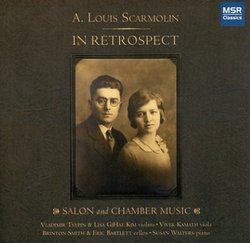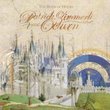| All Artists: Eric Bartlett, Anthony Louis Scarmolin, Susan Walters, Vivek Kamath, Lisa GiHae Kim Title: Scarmolin: In Retrospect - Salon and Chamber Music Members Wishing: 1 Total Copies: 0 Label: MSR Classics Original Release Date: 1/1/2005 Re-Release Date: 2/22/2005 Genre: Classical Styles: Chamber Music, Historical Periods, Classical (c.1770-1830) Number of Discs: 1 SwapaCD Credits: 1 UPC: 681585113523 |
Search - Eric Bartlett, Anthony Louis Scarmolin, Susan Walters :: Scarmolin: In Retrospect - Salon and Chamber Music
 | Eric Bartlett, Anthony Louis Scarmolin, Susan Walters Scarmolin: In Retrospect - Salon and Chamber Music Genre: Classical
Anthony Scarmolin was born in Schio, Italy. His family emigrated to the United States in 1910 and settled in New Jersey, which Scarmolin was to call home for the rest of his life. Scarmolin?s father Angelo, a textile worke... more » |
Larger Image |
CD Details
Synopsis
Album Description
Anthony Scarmolin was born in Schio, Italy. His family emigrated to the United States in 1910 and settled in New Jersey, which Scarmolin was to call home for the rest of his life. Scarmolin?s father Angelo, a textile worker, was a keen musical amateur and gave the young Anthony his first instruction on violin, piano and various other instruments. At the age of about 14, the young musician entered the German Conservatory of Music in New York City, where he studied piano with Bertha Cahn. His earliest compositions, extracurricular efforts, date from this time. These works, given that they were written in the early 1900?s, and in an extremely conservative musical atmosphere, are shockingly prescient in their expressionism and extreme chromaticism. A typical example is Una Discussione (1907), the earliest work on this album. This work comes with an Ivesian program which deals with an argument between "Signor A" and "Signor B." The tension between the two Signori is represented by imitative counterpoint, and their various ideas and talking points are represented by discreet musical ideas of two to seven beats. There are sudden changes of tempo to represent the emotional ebb and flow. When Scarmolin showed his early efforts to the conservatory faculty he was met with incomprehension, and when a hand injury forced postponement (and eventually abandonment) of concert career, he found himself forced to build a career in the reactionary musical climate of early 20th-century America. Accordingly he set aside his modernism and concentrated on commercially marketable forms of music. Over the next two decades he produced a great quantity of salon music, all of it crafted with great charm and facility. He would eventually return to art music, but continued to produce salon pieces well into his last decade. Several of these genre works are included on this disc, including the lilting Valse Caprice, the tarantella-like Strephon (subtitled "Pastoral Dance") and the sentimental Melodie D?Amour. The Petite Mazurka de Concert, Romance and Remembrance are later, unpublished salon works. In 1919, Scarmolin was hired to conduct the orchestra and band at Emerson High School in Union City, New Jersey. By the mid 1930?s he felt secure enough to take time away from the composition of genre music and pursue more artistically ambitious ventures. In 1938 he produced In Retrospect, written for a competition sponsored by and early music performance ensemble looking to inspire new works for old instruments. Originally scored for harpsichord and a consort of viols and later reconfigured for piano quintet, this is a lyrical, and occasionally atmospheric work in a style intended to sound "antique." In 1940, Scarmolin produced Quartet for Strings, his first in this genre. The modernism of his early works is nowhere to be found in the concert works of the 30?s and early 40?s; instead one encounters a lush Romantic sound, not unlike that found in the scores of contemporaneous films. Still, there is a distinctive voice audible, particularly in the brooding slow movement of this work. In the late 1940?s Scarmolin began, gradually, to adopt a comparatively modernist element in his work. Never as expressionistic or chromatic as his early works, the works of his last decades instead tend toward a degree of austerity and astringency and the use of polytonality and whole-tone harmonies. The Second String Quartet of 1955 is typical of this late sound, as is the Evocation of the early 1960?s. This last work, originally written for clarinet, was adapted for violin by Vladimir Tsypin, who performs it here.
Similar CDs
| Patrick Zimmerli & Octurn Book of Hours Genres: Jazz, Pop Label: Songlines | |

 Track Listings (11) - Disc #1
Track Listings (11) - Disc #1

